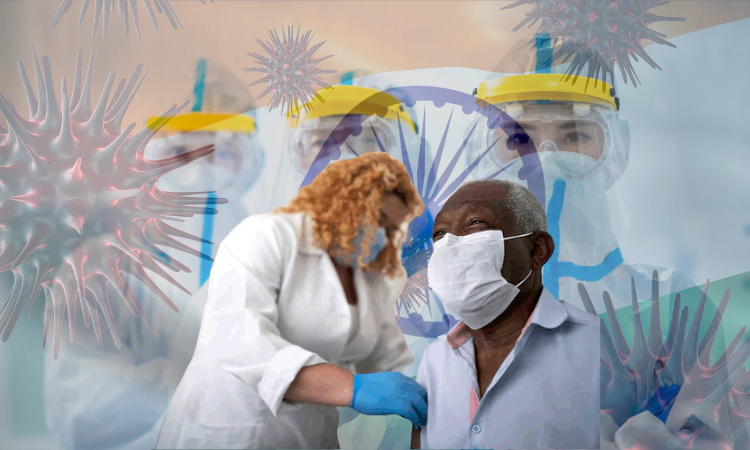Discover the latest news about coronavirus in India, and how their situation affects the world at large.
Highlights:
- India’s coronavirus death toll passed 250,000 on Wednesday, with another 4,205 deaths confirmed over the previous 24 hours, taking the total fatalities to 254,197
- Indian scientists say their work has been hindered by bureaucratic obstacles and the government’s reluctance to share vital data
- India’s most populous state to spend up to $1.36 billion on COVID shots amid a shortage
- UNICEF responding to coronavirus in India
- The coronavirus variant in India has spread in dozens of other countries
- India coronavirus variant declared as a “variant of concern” by the World Health Organization
Coronavirus in India
On Wednesday, India confirmed 4,205 more deaths, setting another daily record and taking its official COVID-19 death toll past 250,000 as its battles a devastating surge in infections.
According to the health ministry, around 370,000 new cases were added in 24 hours, pushing India’s total cases past 23 million.
Furthermore, according to the World Health Organization’s (WHO) latest weekly update, India currently accounted for 93% of COVID-19 deaths in the Southeast Asian region over the past week and nearly a third of global fatalities.
On Tuesday, authorities warned that about 90% of districts in the country are seeing a high positivity rate, sparking fears the coronavirus is spreading to India’s rural areas faster than it did during a surge last year.
COVID-19 infections have swelled in India since February in a disastrous turn blamed on more contagious variants, as well as government decisions to allow massive crowds to gather for religious festivals and political rallies.
Although daily cases have shown very early signs of flattening, experts have cautioned authorities to not let down their guard.
With about 4 million cases still active, healthcare systems remain strained with limited hospital beds, oxygen, and medicine.
Many states have imposed their own restrictions to curb COVID-19 infections, and the southern state of Telangana became the latest to announce a 10-day lockdown on Tuesday.
Calls and pressure for a nationwide lockdown have been mounting.
Indian Scientists and the Obstacles They Face
Indian scientists say that their work has been hindered by bureaucratic obstacles and the government’s reluctance to share crucial data.
India is sequencing around 1% of its total cases, and not all of the results are uploaded to the global database of coronavirus genomes.
According to Alina Chan, a postdoctoral researcher at the Broad Institute of MIT and Harvard who is tracking global sequencing efforts, India uploads 0.49 sequences per 1,000 cases to GISAID, a global data-sharing effort.
The U.S., which had its own troubles with genetic monitoring, uploads about 10 in 1,000, while the U.K. does so for about 82 per 1,000 cases.
India’s Most Populous State to Spend Up To $1.36 Billion On COVID Shots Amid Shortage
India’s most populous state will spend up to $1.36 billion to buy COVID-19 shots and held early talks this week with companies such as Pfizer (PFE.N) and the local partner of the maker of Russia’s Sputnik V, a state official said on Thursday.
The move by Uttar Pradesh, home to more people than Brazil, comes as many Indian states curtail vaccinations due to severe shortages amid a record surge in coronavirus infections, with India recording more than 4,000 deaths for a second straight day as its health system failing to cope.
Uttar Pradesh has also held pre-bid talks with Indian vaccine companies the Serum Institute of India (SII) – licensed to make the AstraZeneca (AZN.L) and Novavax (NVAX.O) shots – Bharat Biotech and Cadila Healthcare (CADI.NS) as part of a global tender to buy 40 million doses over the next few months, state spokesman Navneet Sehgal told Reuters.
He said Johnson & Johnson (JNJ.N) could also confirm their participation in the tender by late Thursday via email. Sputnik V’s local distributor, Dr. Reddy’s Laboratories (REDY.NS), has also held talks.
“Money is not an issue, we have a huge budget,” said Sehgal, a senior bureaucrat in the state of 240 million people. “We will spend up to 100 billion rupees ($1.36 billion)”.
He said funds would have to be diverted from other areas to buy the vaccines.
UNICEF Responding to Coronavirus in India
India is being hit by a devastating new wave of COVID-19 cases. UNICEF is actively working with partners to support the response.
A deadly surge in coronavirus cases is placing an enormous strain on health and critical care facilities in India.
This second wave of the COVID-19 pandemic is larger and spreading more rapidly than the first, and is leaving vulnerable families paying a particularly steep price.
The latest surge is also affecting more people across age groups including children and infants.
UNICEF has already sent critical lifesaving supplies including oxygen concentrators, diagnostic tests, and emergency equipment to help India in its battle with COVID-19. But more support is urgently needed to save lives.
This latest surge will have dire consequences for children in India whose access to essential health, social, protection, and education services will be constrained.
But it is also a reminder that the pandemic is far from over and will continue to pose a threat to all of us unless we continue to work together and take life-saving preventive measures to contain it.
UNICEF is continuing to work with partners to:
- Increase access to life-saving oxygen by procuring and installing oxygen generation plants in hospitals to treat severe and critical COVID-19 cases
- Provide rapid, accurate testing machines in some of the most affected districts
- Support communities and essential workers to weather this storm and prevent further disruption to outreach programs and services for children.
Coronavirus Variant in India Has Spread to Dozens of Other Countries
On Wednesday, the World Health Organization (WHO) said that a variant of COVID-19 behind the acceleration of India’s explosive outbreak has been found in dozens of countries all over the world.
The agency said the B. 1.617 variant of COVID-19, first found in India in October, had been detected in more than 4,500 samples uploaded to an open-access database “from 44 countries in all six WHO regions”.
Further, in its weekly epidemiological update on the pandemic, the WHO adds that they have “received reports of detections from five additional countries.”
Outside India, it said that Britain had reported the largest number of COVID-19 cases caused by the variant.
Earlier this week, the WHO declared B.1.617 – which counts three so-called sub-lineages with slightly different mutations and characteristics – as a “variant of concern”.
It was therefore added to the list containing three other variants of Covid-19 – those first detected in Britain, Brazil, and South Africa.
The variants are seen as more dangerous than the original version of the virus because they are either being more transmissible, deadly, or able to get past some vaccine protections.
The WHO explained on Wednesday that B.1.617 was added to the list because it appears to be transmitted more easily than the original virus, pointing to the “rapid increases in prevalence in multiple countries”.
It also pointed to “preliminary evidence” that the variant was more resistant to treatment with the monoclonal antibody Bamlanivimab, and also highlighted early lab studies indicating “limited reduction in neutralization by antibodies”.
It stressed, though, that “real-world impacts” on the effectiveness of vaccines against the variant for instance “may be limited”.
WHO said the spread of B.1.617, alongside other more transmittable variants, appeared to be one of several factors fuelling India’s dramatic surge in new cases and deaths.
India – a country of 1.3 billion people – is the world’s second-most infected after the United States with nearly 23 million Covid-19 cases, and is currently recording more than 300,000 new cases and close to 4,000 deaths each day.
WHO Says Indian COVID-19 Strain is ‘a Variant of Concern’
As the COVID-19 death toll exceeds 4,000 a day in India, the World Health Organization (WHO) says a coronavirus variant first found in that nation is of global concern.
“We are classifying this as a variant of concern at a global level,” Maria Van Kerkhove, WHO technical lead on COVID-19, told a briefing on Monday, according to Reuters.
“There is some available information to suggest increased transmissibility.”
The variant, B.1.617, is the fourth the WHO has declared a variant of global concern, along with the ones first identified in the United Kingdom, South Africa, and Brazil.
Many nations, including the United States, are limiting travel to and from India because of fears the Indian variant is highly transmissible.
The variant was found in a patient in the San Francisco Bay Area last month.
Van Kerkhove said more information on the Indian variant will be made available soon.
“Even though there is increased transmissibility demonstrated by some preliminary studies, we need much more information about this virus variant and this lineage and all of the sub-lineages,” she said.
The WHO’s chief scientist, Dr. Soumya Swaminathan, told the Wall Street Journal that the B.1.617 spreads quickly.
“The pattern now is that one person in the family gets it, and the whole family seems to get it.
This is unlike the first wave. And so, I think what we’re seeing is more transmissible,” he said.
Meanwhile, the U.S. Centers for Disease Control and Prevention has defined the Indian strain as “a variant of interest.”
The variant has two mutations in the spike protein of the coronavirus that allows it to attach to cells. Indian health officials first detected the variant last month.
The “double mutation” could be of concern if the variant is more transmissible or deadly, but U.S. health officials have not yet called it a “variant of concern.”
References:
https://www.unicef.org/coronavirus/unicef-responding-covid-19-india



